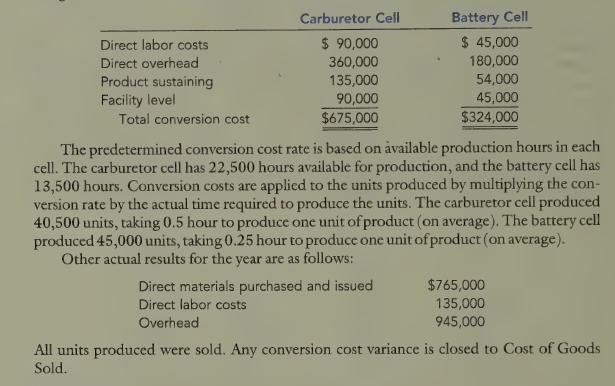Gee Company has implemented a JIT flexible manufacturing system. Gary Polson, controller of the company, has decided
Question:
Gee Company has implemented a JIT flexible manufacturing system. Gary Polson, controller of the company, has decided to reduce the accounting requirements given the expectation of lower inventories. For one thing, he has decided to treat direct labor cost as a part of overhead and to discontinue the detailed direct labor accounting of the past.
The company has created two manufacturing cells, each capable of producing a family of products: the carburetor cell and the battery cell. The output of both cells is sold to a sister division and to customers who use the batteries and carburetors for repair activity.
Product-level overhead costs outside the cells are assigned to each cell using appropriate drivers. Eacility-level costs are allocated to each cell on the basis of square footage. The budgeted direct labor and overhead costs are as follows:
Required:
1. Calculate the predetermined conversion cost rates for each cell.
2. Prepare journal entries using backflush accounting. Assume two trigger points, with completion of goods as the second trigger point.
3. Repeat Requirement 2, assuming that the second trigger point is the sale of the goods.
4. Explain why there is no need to have a work-in-process inventory account.
5. Two variants of backflush costing were presented in which each used two trigger points, with the second trigger point differing. Suppose that the only trigger point for recognizing manufacturing costs occurs when the goods are sold. How would the entries be listed here? When would this backflush variant be considered appropriate?
Step by Step Answer:

Introduction To Cost Accounting
ISBN: 9780538749633
1st International Edition
Authors: Don R. Hansen, Maryanne Mowen, Liming Guan, Mowen/Hansen





